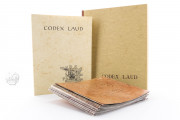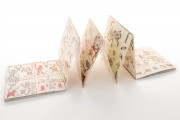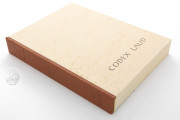The Codex Laud probably dates from the sixteenth century and may have been created at a mercantile center receiving artistic influences from the Nahua and Mixtec peoples, as well as from the coast of the Gulf of Mexico. It is a handbook and almanac for time-based prognostication and related rituals, with most of the content presented from right to left. Despite its nickname, the Codex Laud is not a manuscript composed of folded sheets sewn at the spine but is rather a screenfold, a manuscript folded accordion-style. The content is presented as pictographs (picture writing), a Pan-Mesoamerican method of disseminating information. It is famous for its brilliant colors, expert draftsmanship, and well-planned compositions.
It is closely related to the Codex Fejérváry-Mayer, often referred to as its stylistic twin; indeed, the two manuscripts may be the work of the same workshop or painter-scribe. Crafted of four strips of deerskin coated with a thin layer of plaster, the screenfold is painted using typical Mesoamerican pigments.
Painted on both sides of the support, forty-six of the Codex Laud's forty-eight panels contain images. Noteworthy images include the representation of the rain deity, Tlaloc (p. 23), several pictures featuring the god of death, and four manifestations of the goddess of purity, Tlazolteotl. Its panels measure 15.5 × 16.5 cm. When folded it can be held easily in the hand; when extended its full length, it measures four meters.
Masterful Indigenous Artist and a Mesoamerican Palette
The painter-scribe of the Codex Laud was schooled in indigenous techniques, composition, and pigment use, with the panels often divided into sections using red lines so straight that it is thought that they were drawn using a straightedge.
The delicate black outlines of the figures were skillfully drawn with a pen, not a brush. These are often filled with areas of flat color. Textural details such as feathers, skin, and textiles are rendered in precise geometric patterns.
The painter-scribe had expertise in the chemical and physical properties of pigment preparation and use. The manuscript displays a palette dominated by Maya blue—a pigment created with inorganic clay and organic indigo—and red made from Cochineal, a coloring agent derived from crushed cactus-eating insects. These are complemented by pale yellow, gray, and Cochineal pink.
Focus on Merchant Activity
The Codex Laud and the closely related Codex Fejéváry-Mayer emphasize the activities of merchants and other travelers. Travelers find particular prominence in the six-panel ritual that occupies pp. 17-22 of the Codex Laud, where twenty-two large figures are shown striding from right to left in two rows toward bundled offerings.
From Coastal Mexico to Oxford
The Codex Laud is in a very good state of preservation. The colors, except for some yellow areas where the paint seems to have worn away, are vivid. Its paintings exhibit formal similarities to murals found at Tehuacán in the state of Puebla. Other stylistic features, however, link it to Mixtec and Gulf Coast art.
In 1636 the manuscript became the property of William Laud (1573-1645), Archbishop of Canterbury. It is possible, but by no means certain, that he acquired it from Thomas Howard, Count of Arundel. Laud donated the manuscript to the Bodleian Library at some time between 1635 and 1641, at which time he was serving as the Chancellor of the University of Oxford.
We have 1 facsimile edition of the manuscript "Codex Laud": Codex Laud facsimile edition, published by Akademische Druck- u. Verlagsanstalt (ADEVA), 1966
Request Info / Price





















